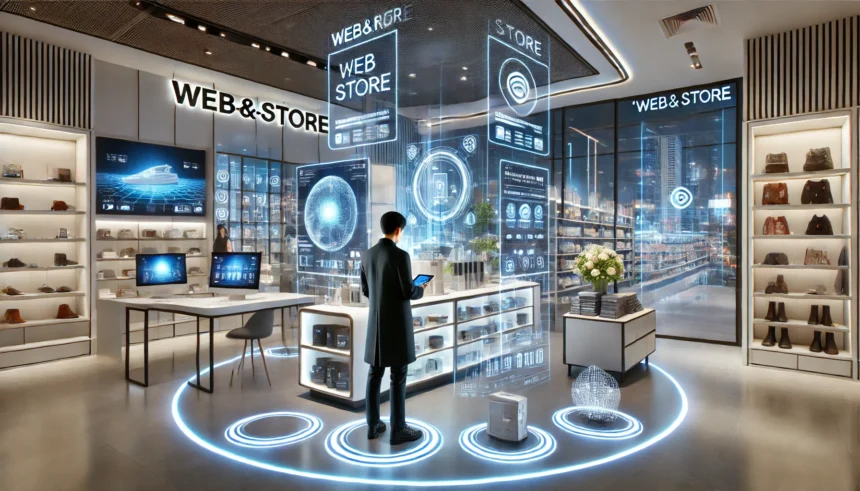The way people shop has transformed dramatically over the past decade. With the rise of e-commerce, traditional brick-and-mortar stores have had to adapt to changing consumer behaviors. At the same time, many customers still enjoy the in-store shopping experience, where they can see, touch, and try products before purchasing. This is where Web&Store comes in—a strategy that seamlessly integrates online and offline shopping to create a more convenient and efficient experience for consumers.
Web&Store is an omnichannel retail approach that allows businesses to offer their products and services across both digital and physical platforms. Customers can browse items online, check availability at local stores, and choose whether to have their orders delivered or pick them up in person. This model not only enhances customer convenience but also boosts sales and operational efficiency for businesses.
Table of Contents
ToggleWhat is Web&Store?
Web&Store is a retail strategy that merges e-commerce and physical retail into a single, connected shopping experience. Unlike traditional e-commerce, where customers rely solely on online browsing and shipping, Web&Store enables buyers to interact with both digital and physical stores throughout their shopping journey.
For example, a customer might research a product online, visit a nearby store to see it in person, and then complete the purchase either in-store or via the website. Similarly, they may order online and pick up the product in-store to save time on shipping. This interconnected approach ensures a seamless and flexible shopping experience.
The Growing Importance of Web&Store
Consumer expectations have evolved, and convenience is now a key factor in purchasing decisions. The rise of smartphones and digital technology has made it easier for shoppers to compare prices, read reviews, and check product availability before making a purchase. Businesses that fail to provide a smooth online-to-offline experience risk losing customers to competitors who do.
Retail giants like Amazon, Walmart, and Target have already adopted Web&Store strategies, offering features like click-and-collect, same-day delivery, and in-store returns for online purchases. This trend is not limited to large corporations—small and medium-sized businesses can also benefit from integrating their online and offline sales channels.
Benefits of Web&Store Integration
Enhanced Customer Convenience
One of the biggest advantages of Web&Store is the convenience it offers to customers. They can shop at their own pace, whether online or in-store, and choose the most suitable delivery or pickup method. Features like curbside pickup, buy online, pick up in-store (BOPIS), and same-day delivery cater to busy shoppers who want flexibility in their purchasing journey.
Increased Sales and Revenue
A well-implemented Web&Store strategy can significantly boost a retailer’s revenue. Customers who visit a store to pick up an online order often end up making additional purchases. Moreover, businesses can reach a wider audience by offering online services while still attracting in-store foot traffic.
Efficient Inventory Management
With real-time inventory tracking, businesses can optimize their stock levels across different locations. Customers can check product availability online before visiting a store, reducing disappointment and improving customer satisfaction. Additionally, stores can use online insights to manage inventory better and avoid overstocking or understocking.
Improved Customer Insights and Personalization
Web&Store allows businesses to collect valuable data on customer behavior, preferences, and purchasing patterns. This data can be used to create personalized recommendations, targeted promotions, and loyalty programs that enhance the shopping experience. For example, if a customer frequently buys electronics online but picks them up in-store, the retailer can offer discounts on related accessories at the point of pickup.
Competitive Advantage
Retailers that integrate their web and store operations gain a significant edge over competitors who rely solely on traditional e-commerce or physical stores. A seamless omnichannel experience builds brand loyalty and encourages repeat purchases, making customers more likely to return.
How to Successfully Implement a Web&Store Strategy
Develop a Unified Digital Platform
A responsive and user-friendly website or mobile app is the foundation of a successful Web&Store strategy. It should include features such as:
- Real-time inventory updates so customers can check product availability
- Store locator functionality to help customers find nearby outlets
- Seamless checkout and payment options for both online and in-store purchases
Offer Click-and-Collect and Flexible Delivery Options
Click-and-collect services allow customers to order online and pick up their purchases from a local store, reducing delivery times and costs. Additionally, offering flexible delivery methods, such as same-day or next-day shipping, enhances customer satisfaction and encourages more sales.
Integrate AI and Chatbots for Customer Support
AI-powered chatbots and virtual assistants can provide instant support to online shoppers, answering common questions, offering product recommendations, and guiding users through the purchase process. This enhances the overall customer experience and reduces the need for human customer support representatives.
Train Staff for an Omnichannel Experience
Employees should be well-versed in handling both online and in-store transactions. Staff training should cover:
- Assisting customers with online orders in-store
- Managing returns and exchanges for online purchases
- Using in-store technology (such as tablets or kiosks) to help customers place orders for out-of-stock items
Implement Omnichannel Payment Solutions
To create a truly seamless experience, businesses should offer multiple payment options, including:
- Online payments through credit cards, digital wallets, and buy-now-pay-later services
- In-store payments via cash, credit/debit cards, or mobile payments
- Hybrid payment options, such as paying online and completing the transaction in-store
Challenges and Solutions in Web&Store Implementation
While Web&Store offers numerous benefits, businesses may encounter challenges when integrating their online and offline operations. Some common obstacles include:
Technical Integration Issues
Ensuring that inventory management systems, online platforms, and in-store POS (point-of-sale) systems are synchronized can be complex. Investing in cloud-based retail management software can help streamline operations and ensure real-time updates.
Logistics and Fulfillment Challenges
Managing deliveries and in-store pickups efficiently requires robust logistics. Businesses should partner with reliable shipping providers and establish efficient warehouse and fulfillment centers to avoid delays and customer dissatisfaction.
Data Security and Privacy Concerns
Handling customer data across multiple platforms increases the risk of security breaches. Implementing strong cybersecurity measures, such as encryption, secure payment gateways, and compliance with data protection regulations, is crucial.
The Future of Web&Store
As technology continues to evolve, Web&Store strategies will become even more sophisticated. Innovations such as augmented reality (AR) shopping, AI-driven personalization, and automated in-store experiences will further enhance the integration of digital and physical retail.
Retailers that embrace Web&Store now will be well-positioned to succeed in the future of commerce. By focusing on customer convenience, data-driven insights, and seamless omnichannel experiences, businesses can stay ahead of the competition and meet the growing expectations of modern consumers.
Read also: Abithelp Tablets: Uses, Benefits, Side Effects, and Precautions
Conclusion
Web&Store is not just a trend—it is the future of retail. As consumers demand greater flexibility, businesses must adapt by integrating their online and in-store shopping experiences. By implementing the right strategies, retailers can enhance customer satisfaction, increase sales, and maintain a competitive edge in the market.
Whether you’re a small business or a large enterprise, adopting a Web&Store approach will help you build a stronger, more resilient brand in today’s rapidly evolving retail landscape.







